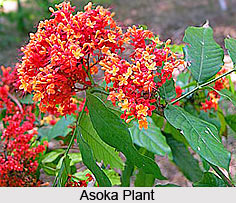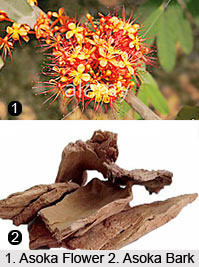 Asoka is a small, fanning out, evergreen tree, with polished brownish bark and compound leaves, forming an impenetrable crown. The Asoka is a rain-forest tree. Its original distribution was in the central areas of the Deccan plateau, as well as the middle section of the Western Ghats in the western coastal zone of the Indian subcontinent. Asoka is one of the holy trees of the Hindus.
Asoka is a small, fanning out, evergreen tree, with polished brownish bark and compound leaves, forming an impenetrable crown. The Asoka is a rain-forest tree. Its original distribution was in the central areas of the Deccan plateau, as well as the middle section of the Western Ghats in the western coastal zone of the Indian subcontinent. Asoka is one of the holy trees of the Hindus.
The Asoka is prized for its beautiful foliage and fragrant flowers. It has dazzling orange flowers in small thick branches and flat fruits with various polished grey seeds. It is a handsome, small, erect evergreen tree, with deep green leaves growing in dense clusters. Its flowering season is around February to April. The Asoka flowers come in heavy, lush bunches. They are bright orange-yellow in colour, turning red before wilting.
Mythology and Tradition
The Asoka tree is considered sacred throughout the Indian subcontinent, especially in India, Nepal and Sri Lanka. In Indian epic poetry, the Asoka tree is mentioned in the Ramayana in reference to the Asoka Vatika (garden of Asoka trees) where Hanuman first meets Sita.
The Asoka tree is worshipped in Chaitra, the first month of the Hindu calendar. It is also associated with Kamadeva, the Hindu god of love, who included an Asoka blossom among the five flowers in his quiver, where Asoka represent seductive hypnosis.
The Asoka tree is closely associated with the Yakshi mythological beings. Often found at gates of Buddhist and Hindu temples, is the sculpture of a Yakshini with her foot on the trunk and her hands holding the branch of a flowering Asoka tree which is based on an ancient tree deity related to fertility.
Components of Asoka Herb
B.N. Ghosh from the School of Tropical Medicine, Kolkata, had investigated the powderised bark ash of Asoka and discovered presence of silica, sodium, potassium, phosphate, magnesium, iron, calcium, strontium and aluminium. A crystalline glycosidal substance has been sequestered from the bark, with galactose as the constitutional sugar. The dried bark of the tree makes up the drug. The bark contains tannins and catechol.
Parts of Asoka Used
The bark, seeds and flowers are mainly used for curing several diseases. All the three parts are used both in fresh and dry forms. Both the forms are turned into concoction to drink and cure the disease.
Health Benefits of Asoka Herb
It is useful in menorrhoea and dysmenorrhoea, depression, bleeding haemorrhoids, uterine fibroids, considered a uterine sedative and tonic. The herb is also useful in Leucorrhoea. Asoka remedies everyday and chronic disorders like uterine disorder, piles, dysentery, diabetes, also serving fruitfully in Ayurvedic medicines. The bark is dictated in Ayurvedic medicine as a uterine tranquilliser. Some of them are discussed below:
Uterine Disorders cured by Asoka
The bark of the tree is effectual for unwarranted blood loss during menstruation due to the presence of uterine fibroids, leucorrhoea and other causes. It is taken as a concoction.
Piles Cured by Asoka
The bark is also effective for internal piles. A concoction made in the similar manner as in the case of uterine disorders is taken in such conditions.
Dysentery Healed by Asoka
The concoction is also handy in times of dysentery. A fluidextract of the flowers can be taken with enhancing results in haemorrhagic dysentery. This infusion is prepared by mashing the flowers with water. It is taken in dosages of 15 to 60 drops.
Other Diseases Remedied by Asoka
The dried flowers of Asoka tree are useful in cases of diabetes. The bark of the tree is also useful in treating scorpion-sting.
Concoction of Asoka Bark
Approximately 90 grams of the bark is boiled in 30 ml of milk and 360 ml of water till the total quantity is reduced to nearly 90 grams. This is shared in 2 or 3 dosages to be administered in a day. The treatment should start from the 4th day of menstruation and continue till the bleeding is controlled. Fresh concoction needs to be made every day.



















